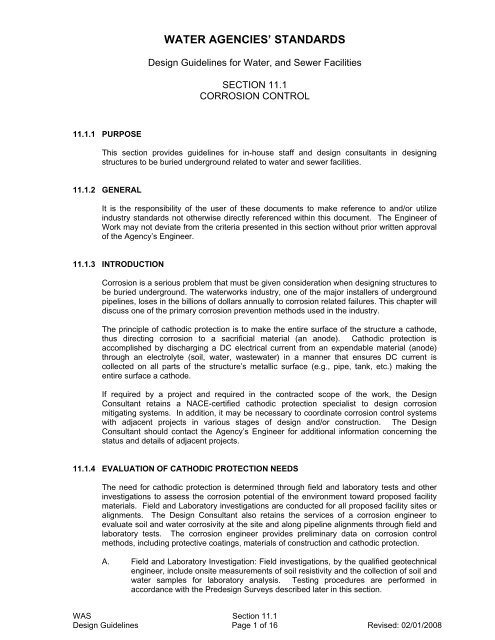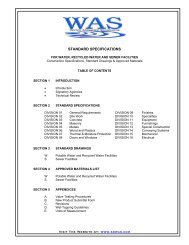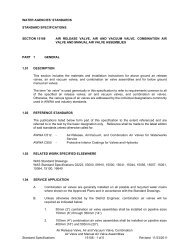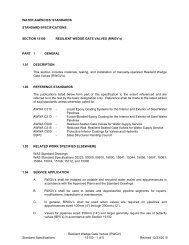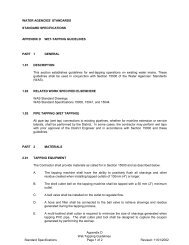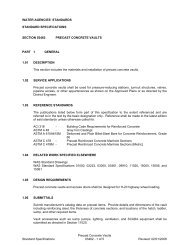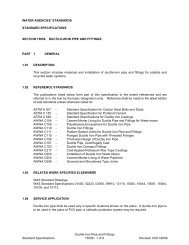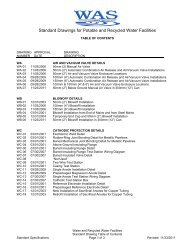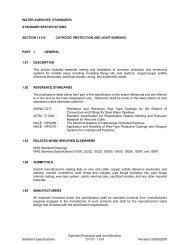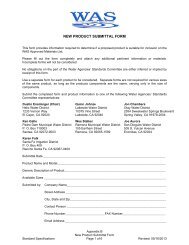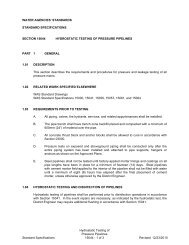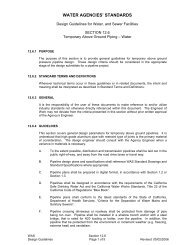Pipeline Corrosion Control Systems - Water Agencies' Standards
Pipeline Corrosion Control Systems - Water Agencies' Standards
Pipeline Corrosion Control Systems - Water Agencies' Standards
Create successful ePaper yourself
Turn your PDF publications into a flip-book with our unique Google optimized e-Paper software.
WATER AGENCIES’ STANDARDS<br />
Design Guidelines for <strong>Water</strong>, and Sewer Facilities<br />
SECTION 11.1<br />
CORROSION CONTROL<br />
11.1.1 PURPOSE<br />
This section provides guidelines for in-house staff and design consultants in designing<br />
structures to be buried underground related to water and sewer facilities.<br />
11.1.2 GENERAL<br />
It is the responsibility of the user of these documents to make reference to and/or utilize<br />
industry standards not otherwise directly referenced within this document. The Engineer of<br />
Work may not deviate from the criteria presented in this section without prior written approval<br />
of the Agency’s Engineer.<br />
11.1.3 INTRODUCTION<br />
<strong>Corrosion</strong> is a serious problem that must be given consideration when designing structures to<br />
be buried underground. The waterworks industry, one of the major installers of underground<br />
pipelines, loses in the billions of dollars annually to corrosion related failures. This chapter will<br />
discuss one of the primary corrosion prevention methods used in the industry.<br />
The principle of cathodic protection is to make the entire surface of the structure a cathode,<br />
thus directing corrosion to a sacrificial material (an anode). Cathodic protection is<br />
accomplished by discharging a DC electrical current from an expendable material (anode)<br />
through an electrolyte (soil, water, wastewater) in a manner that ensures DC current is<br />
collected on all parts of the structure’s metallic surface (e.g., pipe, tank, etc.) making the<br />
entire surface a cathode.<br />
If required by a project and required in the contracted scope of the work, the Design<br />
Consultant retains a NACE-certified cathodic protection specialist to design corrosion<br />
mitigating systems. In addition, it may be necessary to coordinate corrosion control systems<br />
with adjacent projects in various stages of design and/or construction. The Design<br />
Consultant should contact the Agency’s Engineer for additional information concerning the<br />
status and details of adjacent projects.<br />
11.1.4 EVALUATION OF CATHODIC PROTECTION NEEDS<br />
The need for cathodic protection is determined through field and laboratory tests and other<br />
investigations to assess the corrosion potential of the environment toward proposed facility<br />
materials. Field and Laboratory investigations are conducted for all proposed facility sites or<br />
alignments. The Design Consultant also retains the services of a corrosion engineer to<br />
evaluate soil and water corrosivity at the site and along pipeline alignments through field and<br />
laboratory tests. The corrosion engineer provides preliminary data on corrosion control<br />
methods, including protective coatings, materials of construction and cathodic protection.<br />
A. Field and Laboratory Investigation: Field investigations, by the qualified geotechnical<br />
engineer, include onsite measurements of soil resistivity and the collection of soil and<br />
water samples for laboratory analysis. Testing procedures are performed in<br />
accordance with the Predesign Surveys described later in this section.<br />
WAS Section 11.1<br />
Design Guidelines Page 1 of 16 Revised: 02/01/2008
1. Soil/<strong>Water</strong> Tests: Tests are made to characterize the corrosivity of<br />
electrolytes (existing soils and water) in which the structures are to be<br />
located. The required testing is described in the following paragraphs.<br />
2. Field Resistivity Survey: Soil resistivity primarily depends on the chemical<br />
and moisture content of the soil. The higher the level of chemical<br />
constituents, the lower the soil resistivity. Moisture generally decreases soil<br />
resistivity until the maximum solubility of the chemicals is achieved. Beyond<br />
this point, an increase in moisture generally increases resistivity as the<br />
chemicals become more diluted. As Table 11-1 shows, the corrosion of<br />
metals in soil and water normally increases as electrical resistivity decreases.<br />
Table 11-1<br />
Resistivity Values vs. Corrosivity<br />
Soil Resistivity, ohm-cm<br />
Degree of Corrosivity<br />
0-1,000 Very Corrosive<br />
1,000-3,000 Corrosive<br />
3,000-5,000 Fairly Corrosive<br />
5,000-12,000 Mildly Corrosive<br />
Above 12,000<br />
Negligible<br />
Measurements of the electrical resistivity of in-situ soils are made using the<br />
Wenner 4-pin method in accordance with ASTM G57 or other ASTM<br />
approved methods. Tests are made at intervals not exceeding 1,000 feet<br />
along the pipeline alignment or on a 300-foot-square grid at any facility site.<br />
Typically in-situ soil resistivity is measured in ohm-cm from ground level to<br />
depths of 2.5, 5, 7.5, 10, and 15 feet. For deeper structures test depths are<br />
increased to meet specific project requirements.<br />
3. Laboratory Analysis: Soil and water samples are collected in the field for<br />
laboratory analysis to determine their corrosive properties. Tests are<br />
conducted for the following parameters:<br />
• Electrical resistivity using the soil box method defined in ASTM G187<br />
for samples with moisture contents “as-received” and saturated with<br />
deionized water<br />
• Analyze soil/water samples for major soluble salts commonly found,<br />
such as chloride and sulfate, per ASTM D4327 and D513<br />
• pH per CTM 643<br />
Any samples with a pH of less than 6.5 is tested to determine total acidity in<br />
addition to the other required tests. Additional tests may also be warranted<br />
depending on the results of the field resistivity survey.<br />
Laboratory procedures for chemical analysis must be provided.<br />
4. Coordination with Geotechnical Studies: Planning, collection, and<br />
investigation of soil samples is coordinated by both the corrosion and<br />
geotechnical engineers for efficiency in retrieving samples. Soil samples<br />
collected by augers, split-spoon samples or other methods are acceptable.<br />
However, samples should not be taken from holes where a drilling machine<br />
is used, as drilling mud may contain salts that could affect the test results.<br />
WAS Section 11.1<br />
Design Guidelines Page 2 of 16 Revised: 02/01/2008
5. Stray Current Evaluation: The evaluation of stray current requires the use of<br />
a specialty expert in this area. The Design Consultant provides the expertise<br />
necessary to meet these requirements through the use of a cathodic<br />
protection specialist.<br />
Field investigations include interviews with knowledgeable sources and<br />
measurements to determine the potential for stray current from DC sources.<br />
Possible sources of DC current include cathodic protection systems in<br />
operation on other utilities or agencies, electric transit systems, if any, and<br />
industrial sources such as metal processors and welding machines.<br />
Evaluations must also consider the possible effects of cathodic protection<br />
systems for pipelines or facilities under consideration towards other buried<br />
utilities in the vicinity.<br />
6. Coordination with Other Utilities: Other utilities or companies with<br />
underground metallic piping or tank systems that lie in or near the pipeline<br />
alignment must be contacted to determine the extent of potential<br />
interference.<br />
7. Earth Potential Gradient Tests: In conjunction with personnel interviews to<br />
determine probable locations of DC current sources, field measurements of<br />
earth potential gradient are made to detect the presence of current in the<br />
earth at locations along the pipeline alignment. Tests are made by measuring<br />
the potential between two identical portable reference electrodes placed a<br />
suitable distance apart and in contact with the soil. Where appropriate, the<br />
cathodic protection or other electrical system is interrupted to observe the<br />
change in earth potential gradient associated with the system.<br />
8. Induced Voltage: The potential for induced voltage from high voltage<br />
electrical power transmission lines is evaluated if a facility site or alignment is<br />
situated near power lines. Field measurements of the electromagnetic field<br />
may not be sufficient to assess the potential for induced voltage. A specialist<br />
in AC-induced voltage mitigation must evaluate the need for induced voltage<br />
suppression and design the facility accordingly unless the contracted scope<br />
of work specifically excludes this requirement. In any case, the DESIGN<br />
CONSULTANT ensures that induced voltage mitigating devices, if required,<br />
do not interfere with the installed or to be installed cathodic protection<br />
systems.<br />
11.1.5 INTERPRETATION OF RESULTS<br />
The cathodic protection specialist interprets and evaluates results of field and laboratory<br />
investigations and interviews to determine the needs for cathodic protection. The evaluation<br />
includes consideration of the information about protective coatings and linings and materials<br />
of construction.<br />
The results of this evaluation are included in a <strong>Corrosion</strong> <strong>Control</strong> Field Report. This report<br />
includes preliminary studies of corrosion potential and related subjects covered in this<br />
chapter.<br />
11.1.6 STANDARDS AND REFERENCE<br />
The practices and recommendations of accepted references are used during the course of<br />
work. The following references should be considered primary sources if information:<br />
WAS Section 11.1<br />
Design Guidelines Page 3 of 16 Revised: 02/01/2008
A. NACE International: Methods for performing field and laboratory testing, data<br />
collection, and evaluation of results should follow the recommended practices of<br />
NACE International. NACE International is located in Houston, Texas. Particular<br />
attention should be given to the following standard practices and test methods:<br />
• SP0169 <strong>Control</strong> of External <strong>Corrosion</strong> on Underground or Submerged<br />
Metallic Piping <strong>Systems</strong>.<br />
• SP0177 Mitigation of Alternating Current and Lightning Effects on Metallic<br />
Structures and <strong>Corrosion</strong> <strong>Control</strong> <strong>Systems</strong>.<br />
• RP0187 Design Considerations for <strong>Corrosion</strong> <strong>Control</strong> of Reinforcing Steel<br />
in Concrete.<br />
• RP0196 Galvanic Anode Cathodic Protection of Internal Submerged<br />
Surfaces of Steel <strong>Water</strong> Storage Tanks.<br />
• RP0285 <strong>Corrosion</strong> <strong>Control</strong> of Underground Storage Tank <strong>Systems</strong> by<br />
Cathodic Protection.<br />
• SP0286 The Electrical Isolation of Cathodically Protected <strong>Pipeline</strong>s.<br />
• SP0388 Impressed Current Cathodic Protection of Internal Submerged<br />
Surfaces.<br />
• SP0572 Design, Installation, Operation, and Maintenance of Impressed<br />
Current Deep Anode Beds.<br />
• TM0497 Measurement Techniques Related to Criteria for Cathodic<br />
Protection on Underground or Submerged Metallic Piping<br />
<strong>Systems</strong>.<br />
B. American <strong>Water</strong> Works Association <strong>Standards</strong> and Publications: Information on pipe<br />
materials, coatings and corrosion control practices used in the water industry can be<br />
obtained from AWWA in Denver, Colorado.<br />
C. Manufacturers’ Associations: Trade associations may provide supplemental sources<br />
of information about details and common practices for specific materials of<br />
construction. Caution should be used when strictly following their recommendations<br />
because their recommendations may be structured to benefit their particular product.<br />
11.1.7 CORROSION CONTROL REPORT – CONCLUSIONS AND RECOMMENDATIONS<br />
Ductile Iron pipe has different requirements for corrosion control and soil corrosivity<br />
thresholds. This is also true for concrete or cement-mortar coated steel. In general, cathodic<br />
protection in conjunction with highly effective dielectric coatings should be provided for buried<br />
or submerged metallic structures if any of the following conditions exist:<br />
• Soil resistivity is 12,000 ohm-cm or less (measured in the field only) or 5,000 ohm-cm<br />
or less (measured in a laboratory in saturated condition), or when a wide range of soil<br />
resistivities exists regardless of their absolute values.<br />
• Soil with high chloride or sulfate concentrations.<br />
• <strong>Water</strong>s with high chloride concentrations, high TDS, or high dissolved oxygen<br />
concentration (cathodic protection is not effective in waters with high velocity).<br />
• Areas subject to stray electrical currents.<br />
• Support facility steel or ductile iron piping and steel storage tanks.<br />
The evaluation reaches one of two possible conclusions:<br />
A. First possible conclusion: When the study is conducted, cathodic protection is<br />
determined necessary. This conclusion results in the design, installation and<br />
commissioning of cathodic protection systems concurrent with construction of the<br />
facility. The cathodic protection system is designed for a minimum service life of 20<br />
to 30 years, after which it requires replacement or upgrading for continued service.<br />
Cathodic protection systems are normally the impressed current type, unless the<br />
current requirements are low and the current density requirement can be reduced by<br />
providing a highly effective dielectric coating on the facility. When current<br />
WAS Section 11.1<br />
Design Guidelines Page 4 of 16 Revised: 02/01/2008
equirements are 1 to 2 amps or less, the use of cast or ribbon galvanic anodes<br />
(magnesium or zinc) should be considered.<br />
A major consideration for the cathodic protection alternative is that stray current from<br />
the cathodic protection system must be controlled to prevent damage to other<br />
facilities. If not controlled, the cost savings resulting from leak prevention on the<br />
protected facility could be surpassed by the costs of damage to other facilities.<br />
B. Second possible conclusion: When the study is conducted and cathodic protection is<br />
deemed unnecessary at the time of construction, all facilities are then provided with<br />
the test stations. Electrical continuity of the structure is necessary for future needs of<br />
a cathodic protection system. <strong>Corrosion</strong> monitoring results are used to determine<br />
when, or if, cathodic protection is required. The major consideration with this<br />
conclusion is the requirement for a correct future assessment of the need for cathodic<br />
protection.<br />
Therefore, the competent evaluation of the need for cathodic protection can be<br />
difficult. Unless test data demonstrates actual corrosive failure of a facility,<br />
consultants and vendors will offer a wide range of opinions on whether cathodic<br />
protection is required. Future cathodic protection installations will most likely be the<br />
impressed current type because the galvanic anode installations for existing large<br />
facilities are usually prohibitive as adequate amounts of current is limited.<br />
The conclusions and recommendations of the cathodic protection specialist’s and<br />
corrosion engineer’s evaluation for corrosion control on the project are submitted as<br />
the <strong>Corrosion</strong> <strong>Control</strong> Report.<br />
11.1.8 CORROSION CONTROL DESIGN<br />
The design of cathodic protection or corrosion monitoring systems for projects must be in<br />
accordance with the following:<br />
A. Coordination with Structure Design: Coordination with structure design is required to<br />
ensure that the cathodic protection system is fully compatible with the design of the<br />
structure to be protected or monitored. The materials and protective coating<br />
considerations for a particular structure require coordination between the corrosion<br />
engineer and the “specifiers” of the materials of construction and coatings. It is also<br />
necessary to identify locations and configurations of appurtenant facilities such as<br />
valve vaults, service connections, instrumentation, and connections to other<br />
structures.<br />
The approximate locations of cathodic protection or corrosion monitoring equipment,<br />
devices, outlets, and appurtenances are shown on the approved drawings. Exact<br />
locations are determined by the Construction Contractor subject to approval by the<br />
District Engineer.<br />
The District Engineer verifies all data and final locations of work done under other<br />
sections of the specifications required for placing the electrical work.<br />
The cathodic protection engineer coordinates with the Design Engineer’s electrical<br />
discipline staff to be sure that the electrical grounding methods do not accelerate<br />
corrosion of pipes, tanks, and other structures and equipment in the area by creating<br />
corrosion cells or draining protective current from the intended structures to be<br />
protected.<br />
1. Pipe and Equipment Materials: Some pipelines may be constructed from<br />
metallic materials other than steel such as ductile iron, copper, or galvanized<br />
iron. All candidate pipe materials are considered for corrosion mitigation<br />
needs.<br />
WAS Section 11.1<br />
Design Guidelines Page 5 of 16 Revised: 02/01/2008
Underground steel tanks, water immersed gates, valves, steel parts of other<br />
structures, and equipment exposed to corrosive environments may also<br />
receive cathodic protection or may require protection from the adverse<br />
effects of impressed current cathodic protection applied to other structures.<br />
2. Optimization of Coating and Cathodic Protection: Cathodic protection<br />
systems are designed to provide adequate current to polarize the structures<br />
to be protected to levels generally accepted for complete protection.<br />
A key consideration for designing cathodic protection systems is minimizing<br />
the cathodic protection current requirement. This is necessary to minimize<br />
the total current output from cathodic protection facilities reducing the<br />
consumption of anodes and the cost of power supply. The larger the current<br />
output, the greater the chance of stray current interference. Such<br />
interference increases the resultant costs for mitigation.<br />
The current requirement for cathodic protection is a function of several<br />
variables, including the facility surface area to be protected and soil<br />
conditions. The quality and condition of the structure’s protective coating(s)<br />
will determine the current requirement of the structure. The major<br />
determinant in current requirement for a given facility size is its effective<br />
coverage of the protective coating on the facility. A coating with a high<br />
degree of coverage, i.e. few coating holidays, of the pipe surface requires<br />
less current since less of its bare surface is in contact with the soil.<br />
To achieve the most cost-effective corrosion protection system, the<br />
combined facility coating and cathodic protection must be optimized. The<br />
coating must protect most of the facility surface and be complemented by an<br />
appropriate cathodic protection system to protect the uncoated areas or<br />
coating holidays of the pipe surface. The coating is selected for the<br />
appropriate environment and the greatest effective coverage without<br />
excessive cost. The cathodic protection system is selected to deliver<br />
sufficient cathodic protection current areas with coating holidays without<br />
causing stray current interference on other facilities.<br />
3. Stray Current <strong>Control</strong>: Stray current from a cathodic protection system must<br />
be controlled to prevent damage to other facilities. The cost savings<br />
resulting from corrosion prevention on the protected facility could be<br />
surpassed by the cost of damage to other facilities. The cathodic protection<br />
design should provide a means for testing for and mitigating potential stray<br />
currents produced by the system.<br />
4. Grounding Needs: The cathodic protection system is coordinated and<br />
consistent with electrical grounding needs of the facilities to mitigate induced<br />
voltage from high voltage power transmission lines.<br />
Facilities with cathodic protection systems are insulated from electric utility<br />
grounding systems to prevent excessive current requirements and therefore<br />
the waste of energy. This means that facilities such as pumps, electrically<br />
operated equipment, instruments and controls and similar connections<br />
should be electrically insulated from the protected facility to conserve energy.<br />
Facilities equipped with only corrosion monitoring systems are also<br />
electrically isolated from utility grounding systems. This condition lends itself<br />
to the future application of cathodic protection if warranted and prevents to<br />
potential corrosion cells that would otherwise not be present.<br />
WAS Section 11.1<br />
Design Guidelines Page 6 of 16 Revised: 02/01/2008
5. Interfaces between Contracts: Facilities and other structures are designed<br />
and constructed so that the finished system is compatible with existing<br />
structures and facilities, and that corrosion protection is not compromised for<br />
both new and existing structures. Where insulating joints are required, the<br />
Construction Contractor provides and installs the connecting insulating joint<br />
assembly.<br />
B. Cathodic Protection System Types: The type of cathodic protection system selected<br />
by the cathodic protection specialist must provide an acceptable minimal service life<br />
of 20 to 30 years. Factors to be considered during selection are:<br />
1. Galvanic or Sacrificial Anodes: Galvanic anodes use the natural potential<br />
difference (voltage) between two different metal alloys to generate direct<br />
electrical current (DC). These anodes consist of magnesium or zinc castings<br />
or ribbons directly connected to the pipe. With magnesium and zinc being<br />
anodic to steel, ductile and cast-iron, stainless steel, lead and copper, the<br />
anodic material will sacrifice itself to protect the structure they are attached<br />
to.<br />
Zinc anodes should be considered in low resistivity environments (less than<br />
approximately 1,500 ohm-cm) or in brackish or saline water and soil<br />
conditions. In these low resistivity conditions, zinc anodes have a longer<br />
operating life than magnesium anodes because of their lower driving voltage,<br />
hence lower current output, and higher current efficiency. In soil conditions<br />
having higher soil resistivities and where galvanic anodes are required,<br />
magnesium anodes should be used.<br />
The number of anodes depends on the electrolyte conditions and the current<br />
requirement. Anodes are sized to provide a minimum service life of 20 to 30<br />
years. Galvanic anode systems are best suited to applications where current<br />
requirements are low (less than 2 amps), where structures are well-coated,<br />
and in areas of low electrolyte resistivity. Galvanic anode systems are<br />
frequently used where the following items are important:<br />
• No external power supply is available or allowed (classified areas).<br />
• Low maintenance effort needed.<br />
• Minimal interference with other structures is mandatory.<br />
• Low installation cost is mandatory (needs economical comparison).<br />
• Minimal easement or right-of-way needed.<br />
Considerations that discourage the use of galvanic anode systems are:<br />
• Limited driving potential and current output.<br />
• High electrolyte resistivity.<br />
• High cost of retrofit or upgrade.<br />
• Adjustment of output is required.<br />
Where conditions are unfavorable for galvanic anode or sacrificial anode<br />
protection, impressed current systems should be considered.<br />
2. Impressed Current: Impressed current cathodic protection systems are used<br />
when the current requirement is more than can be generated by a galvanic<br />
system. An outside source of power is necessary to operate this type of<br />
system.<br />
Rectifiers should be used to convert alternating current (AC) to direct current.<br />
The DC current goes from the positive DC terminal of the rectifier to the<br />
groundbed (anodes) where it is discharged into the electrolyte. This current<br />
is collected on the structure to be protected. The electrical circuit is<br />
completed as the DC current returns via the protected structure to the DC<br />
WAS Section 11.1<br />
Design Guidelines Page 7 of 16 Revised: 02/01/2008
negative terminal of the rectifier. Typical impressed current anodes are<br />
made of graphite, high-silicon cast iron, mixed-metal oxide coated titanium<br />
and plantinized titanium or niobium.<br />
Impressed current systems are best suited to applications where current<br />
requirements are high, and in areas of high electrolyte resistivity.<br />
Impressed current systems are frequently used where:<br />
• Large current is required.<br />
• High-resistivity soil or water conditions exist.<br />
• Current must be adjustable.<br />
• Contamination of the product is prohibited.<br />
The following considerations may discourage the use of impressed current<br />
systems:<br />
• Slightly higher initial installation cost.<br />
• Skilled maintenance effort.<br />
• Continuous cost for AC power.<br />
• Interference with other structures.<br />
• Congested areas.<br />
• No available power source.<br />
Where conditions are unfavorable for impressed current protection systems,<br />
galvanic or sacrificial anode protection, or a combination of the two methods<br />
should be used.<br />
3. Selection of Protection System: The type of cathodic protection system,<br />
design configuration, and component specifications should be selected to<br />
deliver the required current with due consideration of the control of stray<br />
currents.<br />
The replaceable parts of cathodic protection systems are designed to provide<br />
a service life of 20 to 30 years. This includes items such as rectifiers,<br />
anodes, and wiring. A longer design life is not recommended and is not<br />
economical as the durability of construction materials for continuous use<br />
becomes marginal and the risk of equipment failure increases substantially.<br />
The actual service life and performance of a cathodic protection system may<br />
fluctuate depending on the following:<br />
• The average current output.<br />
• Soil or water conditions.<br />
• Actual anode consumption efficiency.<br />
• The rate of material deterioration.<br />
• The addition of facilities.<br />
The design should incorporate sufficient safety and redundancy factors to<br />
achieve the design life under a reasonable range of conditions.<br />
Features necessary for the operation of the cathodic protection system must<br />
be designed to last for the life of the structure or facility.<br />
C. Consistency Among Contracts: Cathodic protection systems are designed for<br />
consistency among adjacent projects. All system components and configurations are<br />
as required by these standards and guidelines. In the absence of pertinent<br />
standards, the specifications and details of a previously designed facility for previous<br />
projects are used as a reference for consistency.<br />
WAS Section 11.1<br />
Design Guidelines Page 8 of 16 Revised: 02/01/2008
D. Design Criteria for Cathodic Protection: Pumping station, storage facility, pipeline,<br />
and pressure control station project design criteria are as described in these<br />
Guidelines.<br />
E. Construction Phase Considerations: Successful installation and operation of cathodic<br />
protection systems requires special attention to certain details. Examples are<br />
provided in the following paragraphs.<br />
Inspection during the construction of test stations and cathodic protection facilities is<br />
important only for certain parts of the job. Cathodic protection systems are relatively<br />
fragile, so there is considerable potential for mechanical damage. Also, the systems<br />
rely on low voltage and current, therefore, any unplanned resistance in wires and<br />
wire connections could reduce the system effectiveness.<br />
Some important items to be addressed by the Construction Manager during detailed<br />
inspection are as follows:<br />
• Thermite weld wire connections to structures must be sound and properly<br />
insulated from contact with the electrolyte.<br />
• Splices are not allowed in impressed current anode wires or headers.<br />
However, if a splice must be made, it should be in an aboveground splice<br />
box. Splices between galvanic anode lead wires and anode header wires<br />
must be thoroughly insulated from contact with the electrolyte.<br />
• Anodes must be properly positioned and installed without stressing the lead<br />
wire. Wires must be correctly color coded and marked as to function and the<br />
structure to which they are connected. This is especially important for<br />
rectifier output leads and pipeline crossings.<br />
• The power supply to the rectifier must be the correct voltage and phase.<br />
• Electrical continuity of the structure must be tested to ensure that electrical<br />
continuity required by cathodic protection exists. All insulators must be<br />
tested to ensure they are functioning. The loss of an insulator can cause<br />
loss of protection for part or all of the structure.<br />
F. Operation and Maintenance Considerations<br />
Items, which are accessible from the ground, must be checked periodically during the<br />
life of the structures.<br />
Cathodic protection system rectifiers should be monitored quarterly.<br />
The Design Engineer designs facilities for corrosion monitoring and cathodic<br />
protection for periodic access and measurement. Test boxes, rectifiers and other<br />
facilities are placed in accessible locations and away from hazards such as traffic and<br />
areas prone to flooding. Signage is provided for corrosion protection facilities if<br />
streets and walks are not fully developed.<br />
Agency staff must use technical specialists to conduct the appropriate<br />
measurements, maintain records, recommend modifications to the system, and<br />
determine replacement requirements.<br />
11.1.9 STANDARD CORROSION TESTING PROCEDURES<br />
A. Predesign Surveys:<br />
1. Soil Resistivity Testing (Field): In-situ soil resistivity testing is typically<br />
conducted by the Wenner 4-Pin Method. This test procedure requires the<br />
use of an AC resistance meter, such as a Soil Resistance Meter, Model 400,<br />
manufactured by Nilsson Electrical Laboratory, Inc. The Wenner method<br />
requires that 4 electrodes, or pins, be driven into the ground along a straight<br />
line, equidistant from each other, as shown in Figure 11.1.1. An alternating<br />
WAS Section 11.1<br />
Design Guidelines Page 9 of 16 Revised: 02/01/2008
current from the meter flows through the outside probes, C1 and C2. Due to<br />
the resistance of the soil, a voltage drop is created across the inner pins, P1<br />
and P2. This voltage gradient is proportional to the average resistance of the<br />
soil mass to a depth equal to the pin spacing. The resistivity of the soil is<br />
then computed from the meter reading according to the instructions found in<br />
the meters operating manual.<br />
Resistance measurements should be made at 1000-foot intervals, as a<br />
minimum, along the proposed alignment or on 300-foot-square grid at any<br />
facility site. As mentioned, the Wenner 4-Pin method measures average soil<br />
resistivity to a depth equal to the pin spacing. Since it is desirable to obtain<br />
information about the soil conditions at the depth of the structure, pin<br />
spacings should be selected to contain the soil strata in which the structure is<br />
to be located.<br />
2. Soil Resistivity Testing (Laboratory): Soil samples should be extracted from<br />
specific locations and depths. The samples should be packaged<br />
appropriately and tested as soon as practical upon removal to reduce the<br />
effect of changes of in-situ moisture content. Representative samples should<br />
be placed in a soil box, as shown in Figure 11.1.2. The sample resistivity is<br />
determined from the resistance meter reading and the geometry or constant<br />
for the soil box. The testing should be repeated after successive increases in<br />
moisture content with the deionized water. The sample should be retested<br />
after each addition of water, until a minimum value has been reached. This<br />
value should then be recorded as the “minimum” saturated resistivity.<br />
3. Chemical Analyses: Soil samples should be forwarded to a qualified<br />
laboratory specializing in soil corrosivity analysis, for the testing of pH, and<br />
chloride, sulfate, bicarbonate, and other soluble ion concentrations normally<br />
found in soil or water.<br />
Once again, the samples should be analyzed as soon a possible upon<br />
arrival, so as not to cause significant variation in the “as-found” condition of<br />
the sample. Chemical testing is performed in accordance with recognized<br />
standard procedures and reported in (ppm), parts per million. Minimum<br />
standard test procedures include ASTM D513, ASTM D4327, ASTM G187,<br />
and CTM 643.<br />
When collecting soil samples representative of the structure’s environment,<br />
samples should also be taken above the structure to account for changes<br />
due to moist conditions or leaching of material or chemicals from upper soil<br />
strata.<br />
4. Structure-to-Electrolyte Potential Surveys: Half cell potential surveys should<br />
be incorporated in a predesign survey where a structure is located. Ideally,<br />
the testing is performed at test station locations. Where test stations have<br />
not yet been installed, electrical connection must be made to the structure at<br />
appurtenances. The voltmeter to be used in the testing must have an input<br />
impedance of at least 10 meg-ohms. The testing must also be performed<br />
with a calibrated copper/copper sulfate reference electrode (CSE), which is<br />
known to be functioning properly.<br />
If an analog voltmeter is used, the positive test lead is connected to the<br />
copper copper/sulfate reference electrode and the negative test lead is<br />
connected to the structure. If a digital voltmeter is used, the positive test lead<br />
is connected to the structure and the negative test lead is connected to the<br />
reference electrode. The reference electrode is placed as close to the<br />
structure as possible, as shown in Figure 11-1-2. The use of water at the<br />
CSE location may be advisable to reduce contact resistance between the<br />
CSE and the soil. The potential is recorded in millivolts,(mV) and a notation<br />
WAS Section 11.1<br />
Design Guidelines Page 10 of 16 Revised: 02/01/2008
is made indicating the test station number and any other relevant information<br />
such as pipeline station number.<br />
Where structure-to-electrolyte potential measurements are to be performed<br />
on a structure under galvanic cathodic protection, the potential of the<br />
structure should be recorded with the anode both connected and<br />
disconnected from the structure. The open circuit potential of the anode<br />
must also be recorded. Where the cathodic protection system is an<br />
impressed current type, the potential of the structure is recorded prior to and<br />
during temporary interruption of cathodic protection current, or “instant off”<br />
using a current interrupter.<br />
5. Current Requirement Testing: Current requirement testing is generally<br />
performed to determine how much current is needed to protect a structure,<br />
regardless of the type of system planned for design. Testing requires the<br />
use of a portable DC power supply, voltmeter with shunt or an ammeter,<br />
reference electrode, test leads, temporary anodes, and means for making an<br />
electrical connection to the structure. The temporary anodes may be an<br />
existing structure (for example a chain link fence) or an anode system<br />
installed for the purpose of testing. The power supply may be a portable<br />
rectifier or power supply or a battery. The positive lead from the power<br />
supply should be connected to the temporary anodes and the negative lead<br />
to the structure, as shown in Figure 11-1-3. Pipe-to-soil potential<br />
measurements should be made a multiple locations prior to energization of<br />
the structure. These locations should be selected to facilitate testing both<br />
close to and far away from the temporary anode location so that attenuation<br />
characteristics, as defined in “<strong>Corrosion</strong> <strong>Control</strong> Testing” can be estimated, in<br />
addition to the levels of polarization achieved during testing. The potentials<br />
should be recorded both with the DC power “on” and “off.” The voltage and<br />
current outputs should all be recorded for each test setup. Multiple<br />
measurements maybe required for incremental increases in current and<br />
polarization potentials to calculate or project the final anticipated current<br />
required for the purpose of design of the cathodic protection system.<br />
B. Electrical Continuity Testing:<br />
1. Testing for <strong>Pipeline</strong>s: Electrical continuity testing for bonded pipe joints is<br />
performed after backfilling of the pipe. Testing requires the use of a power<br />
supply, volt and ammeter or multimeter, test leads, and means of making two<br />
electrical connections to the pipe. The positive and negative terminals of the<br />
power supply should be connected to the pipeline at a known distance along<br />
the pipeline to be tested. The length of pipe and number of joints must be<br />
recorded, as well as the voltage and current output of the power supply. The<br />
resulting voltage drop from the application of current on the pipe span being<br />
tested should be measured and recorded. This testing may be done along<br />
the length of pipe or across individual pipe joints, as required and shown in<br />
Figure 11-1-4. From the power supply outputs and the voltage drops<br />
measured, the resistance of the test pipeline span can be calculated. This<br />
value should be compared to the theoretical resistance of the pipe and joint<br />
bonds for the span being tested. These calculations are based upon pipe<br />
material, size, wall thickness, and joint bond wire gage and length. Field test<br />
results of no more than 120% of the theoretical resistance value indicate the<br />
pipe is continuous.<br />
2. Isolation Testing: Insulating flange kits and dielectric unions are tested using<br />
a Gastronics Model 601 Insulation Checker, or with other proven test<br />
methods. The meter is placed across the flange or other insulating device<br />
being tested. Electrical isolation is sufficient when the meter reading is<br />
100%. Care must be taken when using the insulation checker, especially<br />
when pipe larger than twenty four inches (24”) in diameter are involved. Two<br />
WAS Section 11.1<br />
Design Guidelines Page 11 of 16 Revised: 02/01/2008
(2) test methods for electrical isolation should be performed and be in<br />
agreement.<br />
C. Post Installation Testing: Post installation testing is performed as required in the<br />
plans and specifications for the project and as directed by the Construction Manager.<br />
Testing requires the performance of the standard test methods presented in this<br />
attachment. The minimum requirements are as listed in the test method or as<br />
required by the Construction Manager and shown on the drawings and specifications.<br />
Figure 11.1.1<br />
Wenner 4 Pin Method for Measurement of Soil Resistivity<br />
WAS Section 11.1<br />
Design Guidelines Page 12 of 16 Revised: 02/01/2008
Figure 11.1.2<br />
Soil Box Method<br />
Figure 11.1.3<br />
Pipe-to-Soil Potential Measurements<br />
WAS Section 11.1<br />
Design Guidelines Page 13 of 16 Revised: 02/01/2008
Figure 11.1.3 (continued)<br />
Pipe-to-Soil Potential Measurements<br />
Figure 11.1.4<br />
Current Requirement Test<br />
WAS Section 11.1<br />
Design Guidelines Page 14 of 16 Revised: 02/01/2008
Figure 11.1.5<br />
Continuity Bond Testing<br />
11.1.10 REFERENCE<br />
A. Should the reader have any suggestions or questions concerning the material in this<br />
section, contact one of the member agencies listed.<br />
B. The publications listed below form a part of this section to the extent referenced and<br />
are referred to in the text by the basic designation only. Reference shall be made to<br />
the latest edition of said publications unless otherwise called for. The following list of<br />
publications, as directly referenced within the body of this document, has been<br />
provided for the users convenience. It is the responsibility of the user of these<br />
documents to make reference to and/or utilize industry standards not otherwise<br />
directly referenced within this document.<br />
1. <strong>Water</strong> Agencies’ <strong>Standards</strong> (WAS):<br />
2. Others:<br />
a. Design Guidelines:<br />
1. Section 11.2, <strong>Corrosion</strong> <strong>Control</strong> Design<br />
b. Standard Specifications:<br />
1. Section 13110, Cathodic Protection and Joint Bonding<br />
c. Standard Drawings:<br />
1. WC – Series Cathodic Protection Details<br />
a. NACE International:<br />
1. SP0169, <strong>Control</strong> of External <strong>Corrosion</strong> on Underground or<br />
Submerged Metallic Piping <strong>Systems</strong>.<br />
WAS Section 11.1<br />
Design Guidelines Page 15 of 16 Revised: 02/01/2008
2. SP0177, Mitigation of Alternating Current and Lightning<br />
Effects on Metallic Structures and <strong>Corrosion</strong> <strong>Control</strong><br />
<strong>Systems</strong>.<br />
3. RP0187, Design Considerations for <strong>Corrosion</strong> <strong>Control</strong> of<br />
Reinforcing Steel in Concrete.<br />
4. RP0196, Galvanic Anode Cathodic Protection of Internal<br />
Submerged Surfaces of Steel <strong>Water</strong> Storage Tanks.<br />
5. RP0285, <strong>Corrosion</strong> <strong>Control</strong> of Underground Storage Tank<br />
<strong>Systems</strong> by Cathodic Protection.<br />
6. SP0286, The Electrical Isolation of Cathodically Protected<br />
<strong>Pipeline</strong>s.<br />
7. SP0388, Impressed Current Cathodic Protection of Internal<br />
Submerged Surfaces.<br />
8. SP0572, Design, Installation, Operation, and Maintenance of<br />
Impressed Current Deep Anode Beds.<br />
9. TM0497, Measurement Techniques Related to Criteria for<br />
Cathodic Protection on Underground or Submerged Metallic<br />
Piping <strong>Systems</strong>.<br />
b. American <strong>Water</strong> Works Association <strong>Standards</strong> (AWWA) <strong>Standards</strong><br />
and Publications<br />
END OF SECTION<br />
WAS Section 11.1<br />
Design Guidelines Page 16 of 16 Revised: 02/01/2008


